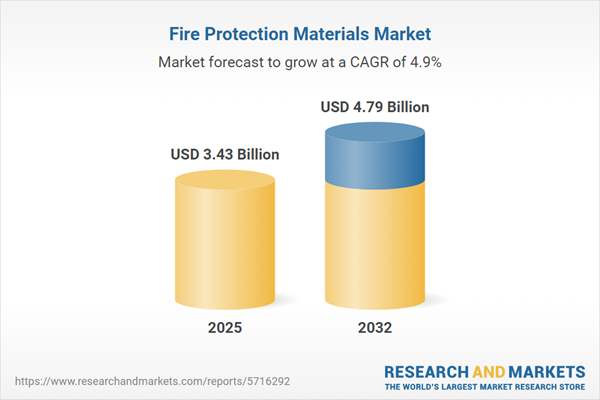Speak directly to the analyst to clarify any post sales queries you may have.
Fire protection materials are at the heart of advanced safety systems, supporting critical infrastructure and modernizing risk mitigation strategies across various industries. As technology and compliance requirements evolve, industry leaders must clearly navigate this dynamic sector to ensure effective investment and operational decisions.
Market Snapshot: Robust Growth in the Fire Protection Materials Market
The global fire protection materials market grew from USD 3.27 billion in 2024 to USD 3.43 billion in 2025. It is projected to expand at a CAGR of 4.90%, reaching USD 4.79 billion by 2032. This growth reflects heightened demand for both new builds and retrofits, as well as widespread adoption of advanced materials and intelligent systems within the sector.
Scope & Segmentation of the Fire Protection Materials Market
This report delivers an in-depth analysis across several essential criteria:
- Protection Types: Active protection (including fire detection systems such as heat detectors and smoke detectors; fire suppression systems involving gas-based and water-based networks) and passive protection (comprising fire doors, fire resistant walls, and fireproof coatings).
- Material Types: Cement, gypsum, intumescent coatings (solvent-based and water-based), and steel.
- End Use Industries: Commercial (education, healthcare, hospitality, retail), industrial (manufacturing, oil & gas, power generation), and residential (multi-family and single-family homes).
- Distribution Channels: Direct sales, distributors, and multiple online options such as company websites and third-party e-commerce.
- Regional Coverage: Americas (including North America and Latin America), Europe, Middle East & Africa, and Asia-Pacific, with national-level analysis for major economies within each region.
- Leading Companies Profiled: The Sherwin-Williams Company, PPG Industries Inc., RPM International Inc., Akzo Nobel N.V., BASF SE, 3M Company, Saint-Gobain S.A., Axalta Coating Systems Ltd., Owens Corning, and Nippon Paint Holdings Co., Ltd.
Key Takeaways for Senior Decision-Makers
- Stringent regulatory frameworks are driving more rigorous testing, while sustainability is becoming central to product development strategies in the fire protection materials market.
- Integration of AI-driven sensors and IoT-enabled systems is accelerating, improving early detection and enabling predictive maintenance capabilities.
- Material advances such as bio-based intumescent coatings and modular passive protection elements address both installation efficiency and environmental priorities.
- Segment adoption varies: commercial and industrial applications require fully integrated solutions, while residential markets increasingly embed both passive and active safeguards during initial design.
- Direct sales and digital channels are gaining prominence, enhancing customer engagement and expanding reach, particularly in emerging markets.
- Collaborations, mergers, and partnerships across the value chain are shaping competitive strategies and driving portfolio diversification.
Tariff Impact on Market Structure and Sourcing
Recent United States tariff adjustments affecting raw materials and finished fire protection products have prompted strategic shifts. Organizations are reconfiguring supply chains, increasing inventory buffers, exploring alternative sourcing options, and investing in domestic production capabilities. These adaptations, in response to tariff pressures, have spurred further innovations in manufacturing processes and a stronger focus on cost optimization throughout the sector.
Methodology & Data Sources
The analysis synthesizes findings from executive interviews, consultations with regulatory authorities, and insights from R&D teams. Supplementary secondary research included industry reports, policy reviews, and validation through proprietary databases and global expert input. Data clarity and reliability were ensured through scenario modeling and rigorous cross-verification protocols.
Why This Report Matters for Market Leaders
- Offers a strategic lens on emerging opportunities and challenges amidst shifting regulatory, tariff, and environmental requirements.
- Enables informed decisions for product development, risk mitigation, and regional expansion in a complex, rapidly evolving sector.
Conclusion
The fire protection materials market is evolving rapidly, shaped by regulatory drivers, regional growth, and advances in material science. Executives equipped with these insights are prepared to steer their organizations toward safer, more resilient, and compliant operations across all sectors.
Additional Product Information:
- Purchase of this report includes 1 year online access with quarterly updates.
- This report can be updated on request. Please contact our Customer Experience team using the Ask a Question widget on our website.
Table of Contents
3. Executive Summary
4. Market Overview
7. Cumulative Impact of Artificial Intelligence 2025
Companies Mentioned
The companies profiled in this Fire Protection Materials market report include:- The Sherwin-Williams Company
- PPG Industries, Inc.
- RPM International Inc.
- Akzo Nobel N.V.
- BASF SE
- 3M Company
- Saint-Gobain S.A.
- Axalta Coating Systems Ltd.
- Owens Corning
- Nippon Paint Holdings Co., Ltd.
Table Information
| Report Attribute | Details |
|---|---|
| No. of Pages | 198 |
| Published | October 2025 |
| Forecast Period | 2025 - 2032 |
| Estimated Market Value ( USD | $ 3.43 Billion |
| Forecasted Market Value ( USD | $ 4.79 Billion |
| Compound Annual Growth Rate | 4.9% |
| Regions Covered | Global |
| No. of Companies Mentioned | 11 |









